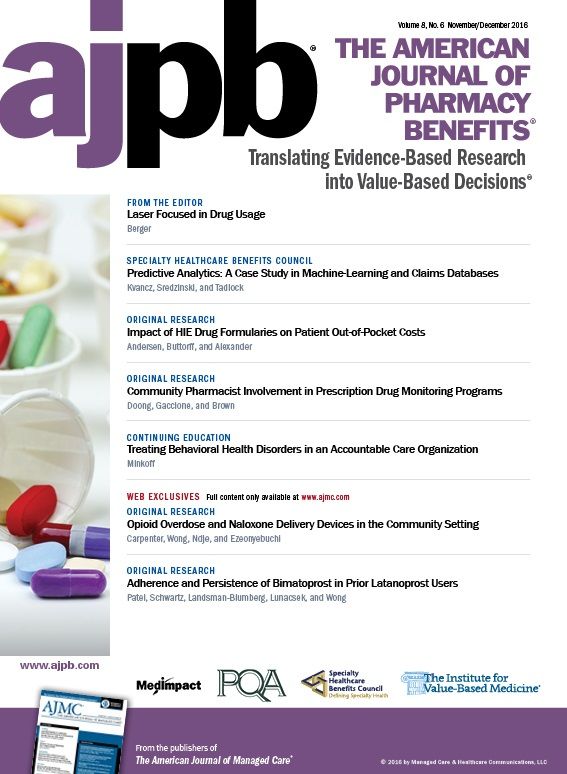Publication
Article
AJPB® Translating Evidence-Based Research Into Value-Based Decisions®
Community Pharmacist Involvement in Prescription Drug Monitoring Programs
Author(s):
The involvement of community pharmacists is vital to reduce prescription drug abuse through the use of Electronic Prescription Drug Monitoring Programs.
ABSTRACT
Electronic Prescription Drug Monitoring Programs (PDMPs) were created in the effort to reduce opioid abuse. However, the full potential impact of these programs has not been realized because enrollment for all healthcare providers is not mandatory. Community pharmacists can help improve quality of care and play a more active role in the patient care process through the use of PDMPs. Limitations to implementing PDMP use in community pharmacy practice include administrative burden, technical issues, and prescriber concerns. This article addresses these concerns and emphasizes the importance of community pharmacists’ involvement in decreasing prescription drug abuse through the use of PDMPs. However, their impact is limited without mandatory involvement from other healthcare providers.
Am J Pharm Benefits. 2016;8(6):227-229
Opioid abuse and overdose has become a national epidemic. According to the CDC, 44 people die each day from an overdose of prescription painkillers.1 It also reported that, in 2013, approximately 2 million Americans, aged 12 years or older, had abused or were dependent on opioids.
Between 1997 and 2007, the distribution of opioid medications increased 7-fold, leading to increased drug diversion.2 The National Institute on Drug Abuse reported in 2014 that the number of unintentional overdose deaths from prescription pain relievers had more than quadrupled since 1999.3
Several interventions have been implemented to combat this epidemic. Initiatives include: primary prevention education; overdose education, including naloxone distribution; expansion of treatment programs; proactive law enforcement efforts to identify doctor-shopping and pill mills; development of evidence-based practice guidelines to reduce opioid overprescribing; and the creation and use of Prescription Drug Monitoring Programs (PDMPs).4 One intervention in which the pharmacist can have a prominent role is PDMPs.
PDMPs began in 2003 to electronically collect data on the prescribing and dispensing of controlled substances (schedule II-IV). Community pharmacies supply data on prescriptions dispensed, and then healthcare providers—such as physicians, nurses, and pharmacists—access these statewide databases. Other information gathered includes the name of the prescribing physician and their Drug Enforcement Administration (DEA) number, the date the prescription was written, and where and when the prescription was dispensed.
PDMPs can be one of the most effective interventions, but the full benefits have not been seen because their use is not mandatory in all states. According to the Prescription Drug Monitoring Program Training and Technical Assistance Center at Brandeis University, currently 49 states, and Guam, have operational PDMPs.
However, only 10 states require prescribers and dispensers to enroll and use these programs, 21 states make it mandatory only for prescribers, and 19 states have no mandatory use requirement.5 In more than half the states with operational PDMPs, prescribers and dispensers are not obligated to enroll. Research has shown a slower increase in opioid abuse in states that utilize PDMPs.6
PROS OF PHARMACIST INVOLVEMENT IN PDMPs
Improve Quality of Care
Through PDMPs, the pharmacist can access information regarding controlled substance use and act as another checkpoint in the medication distribution process. As a result, they can determine if prescriptions are consistent with clinical practice to help improve clinical outcomes and quality of care.
For properly prescribed controlled substances, pharmacists would also be able to use the information from PDMPs to monitor patient adherence. This allows them to identify barriers to adherence and evaluate whether the current regimen is the best for the individual patient.
Pharmacists can utilize PDMPs to identify polypharmacy patients, especially those who are being managed by multiple prescribers. The concurrent use of multiple controlled substances can be dangerous and puts patients at high risk of adverse events. For example, the concurrent use of benzodiazepines and opioid analgesics incurs an increased risk for overdose due to their synergistic pharmacological effects.3
PDMPs can assist patients who are using controlled substances for legitimate medical purposes, as well as patients who have developed an opioid addiction. This creates an opportunity for pharmacists to intervene and provide patients and their families the appropriate resources to obtain treatment.
Reduce Doctor-shopping and Fraudulent Prescribing
The majority of practitioners appropriately prescribe controlled substances; however, some prescribers find ways to manipulate the system for personal gain. To decrease fraudulent prescribing and doctor-shopping, the information from PDMPs can help pharmacists recognize suspicious activity and prescribing trends within their community. If prescribers and patients are aware that the pharmacist is constantly monitoring the entire database, they would be less likely to continue these illegitimate activities.
CONS OF PHARMACIST INVOLVEMENT IN PDMPs
Technical Problems
One major concern regarding PDMPs is the potential for lag time between prescribing, dispensing, and reporting. For example, pharmacists in Massachusetts were required to report data to the PDMP only on a weekly basis, but the requirement has recently changed to daily.7
Although pharmacists can access the information from PDMPs in real time, the data may not be up-to-date. There is also limited interoperability amongst states and a lack of PDMP standardization.
Implementing new technology, such as PDMPs, into the pharmacy can cause an array of problems. With proper training, the PDMP system is not complex, but it is cumbersome since it incurs an additional administrative process which impairs workflow.
While each patient has a unique profile, the information entered by PDMP operators may not always be complete or accurate. In certain circumstances, there may also be multiple profiles for the same patient.
Since PDMPs are not integrated within the pharmacy’s computer system, it may be frustrating for pharmacists to log into a separate database for each controlled substance prescription. It is a time-consuming process to access, update, and evaluate the information from the database.
Prescribing and Dispensing Concerns
If physicians are concerned about being flagged for prescribing large amounts of controlled substances, they may be more reluctant to prescribe them. This could be disadvantageous for the patients who need controlled substances. The potential for legal repercussions associated with inappropriate prescribing may further deter physicians and impact their clinical judgment.
Since pharmacists are not always aware of the clinical status of patients who use controlled substances, they can be more suspicious of certain prescribers. Physicians may feel aggravated if pharmacists are constantly questioning their clinical judgments.
Pharmacists are not experts on substance abuse; however, they are experts on medications, and by using the information from PDMPs, they can discover patients who are potentially abusing these medications. Due to their corresponding liability, pharmacists may face uncomfortable situations that they are not fully equipped to handle.
In addition, the individual’s behavior may be unpredictable, which can be an obstacle for the pharmacist and lead to potentially dangerous situations for co-workers, other patients, and themselves when the opioid use is questioned based on evidence contained in the PDMP.
Pharmacy Issues
Pharmacists are required to put in extra time and effort to learn, implement, access, and maintain PDMPs, but there are no incentives (either monetary or nonmonetary) provided for these additional tasks. There is already a large administrative burden associated with controlled substances.
For example, each state has a variety of rules and regulations concerning the distribution of these medications, which require pharmacies to use a special ordering process involving separate documentation and forms. Federal law also requires a biannual inventory of controlled substances; however, some state laws mandate a perpetual inventory, which adds to the responsibilities of pharmacists. Using PDMPs in community pharmacies further increases the administrative burden because it requires pharmacists to consistently monitor and use the database, hindering workflow.
A cost-effective approach must be developed to incorporate PDMP usage into the pharmacy workflow. Pharmacies operate on very low profit margins and do not receive government subsidies to stay in business. It is unfair to ask pharmacies to absorb the costs associated with integrating and maintaining PDMPs in their workflow without providing incentives or reimbursements.
ADDRESSING CONCERNS REGARDING PHARMACIST INVOLVEMENT IN PDMPs
Despite the concerns regarding PDMPs in community pharmacy practice, when pharmacists consistently use these systems, their impact is invaluable. It is the ethical duty of healthcare professionals, including pharmacists, to improve the health outcomes of their patients and serve their needs.
For the most part, PDMPs only require 1 computer and at least 1 educated pharmacist to operate smoothly, no matter the size or location of the pharmacy. To address the concerns regarding the lack of reimbursements, we recommend that a study be performed to determine the actual cost of providing controlled substances and corresponding services such as the use of PDMPs. Based on the results of the study, appropriate action can then be recommended.
It is understandable that the incorporation of consistent PDMP usage in community pharmacies is frustrating to pharmacists when prescribers are not required to do the same. The current role of pharmacists is to serve as an additional check, prior to medication distribution to patients.
Without requiring prescribers to properly use PDMPs, pharmacists are faced with limited options for resolution when encountering inappropriate prescription use. Pharmacists can either choose not to fill the prescription or send the patient back to the physician, and neither option is beneficial or efficient.
Although PDMPs are monitored by the DEA, local law enforcement, and various professional boards, the programs will not be effective in improving the opioid epidemic until both prescribers and pharmacists are required to use the program prior to prescribing and dispensing.
CONCLUSIONS
PDMPs should be employed and mandated in community pharmacies to improve patient care and outcomes, and to combat the opioid epidemic, after the issues identified in this paper have been addressed. The involvement of pharmacists will improve quality of patient care, and will reduce overprescribing, doctor-shopping, pill mills, and drug diversion.
Successful implementation of PDMPs in community pharmacies would be immensely beneficial for healthcare providers, patients, the public, law enforcement, public health agencies, and the funders of healthcare. However, this impact can be achieved only with the consistent and mandatory usage of PDMPs with the appropriate education, tools, and resources in the collaborative patient care process.
Author Affiliations: School of Pharmacy (KSD, DMG) and Clinical Instructor and Vice Chair, Department of Pharmacy & Health Systems Sciences, School of Pharmacy (TAB), Bouvé College of Health Sciences, Northeastern University, Boston, MA.
Source of Funding: None.
Author Disclosures: The authors report no relationship or financial interest with any entity that would pose a conflict of interest with the subject matter of this article.
Authorship Information: Concept and design (KSD, DMG, TAB); acquisition of data (KSD, DMG); analysis and interpretation of data (KSD, DMG); drafting of the manuscript (KSD, DMG, TAB); critical revision of the manuscript for important intellectual content (KSD, DMG, TAB); statistical analysis (KSD, DMG, TAB); and supervision (TAB).
Address Correspondence to: Todd A. Brown, MHP, RPh, Northeastern University School of Pharmacy 140 The Fenway R218, Boston., MA 02115. E-mail: [email protected].
References
- Injury prevention & control: opioid drug overdose. CDC website. http://www.cdc.gov/drugoverdose/. Published 2015. Updated September 16, 2015. Accessed November 3, 2015.
- Centers for Disease Control and Prevention. CDC grand rounds: prescription drug overdoses—a U.S. epidemic. MMWR Morb Mortal Wkly Rep 2012;61(1):10-13.
- Volkow ND. America’s addiction to opioids: heroin and prescription drug abuse. National Institute on Drug Abuse website. http://www.drugabuse.gov/about-nida/legislative-activities/testimony-to-congress/2015/americas-addiction-to-opioids-heroin-prescription-drug-abuse. Published May 14, 2014. Accessed September 21, 2015.
- Volkow ND. What is the federal government doing to combat the opioid abuse epidemic? National Institute of Drug Abuse website. https://www.drugabuse.gov/about-nida/legislative-activities/testimony-to-congress/2015/what-federal-government-doing-to-combat-opioid-abuse-epidemic. Published May 1, 2015. Accessed October 20, 2015.
- PDMP mandatory query by prescribers and dispensers. Prescription Drug Monitoring Program Training and Technical Assistance Center website. http://www.pdmpassist.org/pdf/Mandatory_Query.pdf. Published Accessed October 18, 2016.
- Gugelmann HM, Perrone J. Can prescription drug monitoring programs help limit opioid abuse? JAMA. 2011;306(20):2258-2259. doi: 10.1001/jama.2011.1712.
- MA PMP Data Entry and Data Submitter’s Guide Utilizing ASAP 4.2. MA PMP Pharmacy Guide. Massachusetts Executive Office of Health and Human Services website. http://www.mass.gov/eohhs/docs/dph/quality/drugcontrol/pmp-pharmacy-submitters-guide-asap42.pdf.

Newsletter
Stay informed on drug updates, treatment guidelines, and pharmacy practice trends—subscribe to Pharmacy Times for weekly clinical insights.






